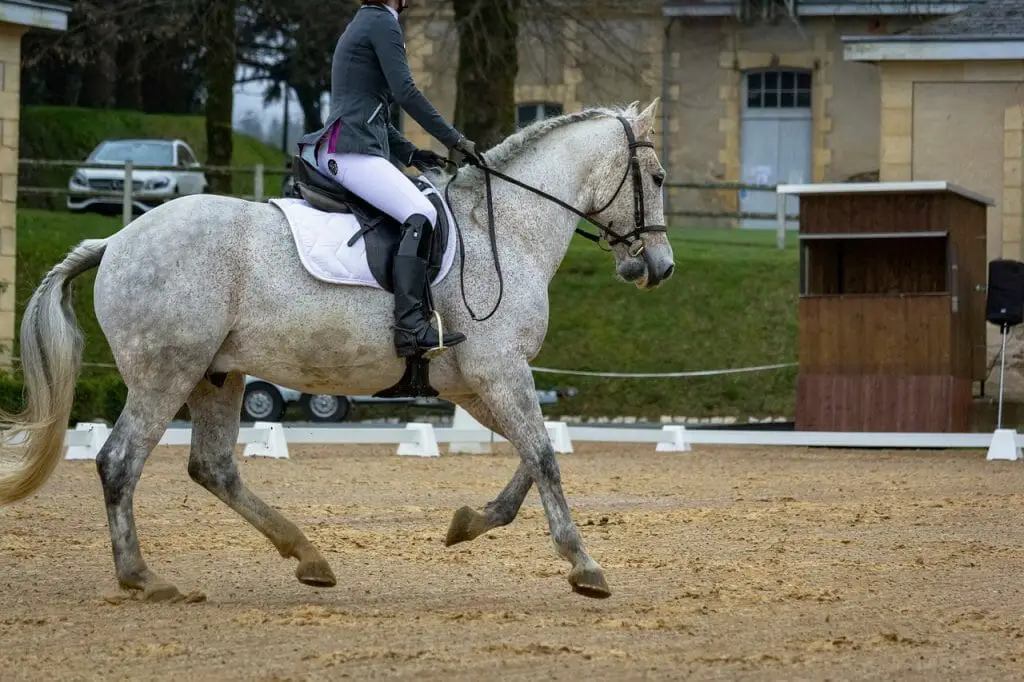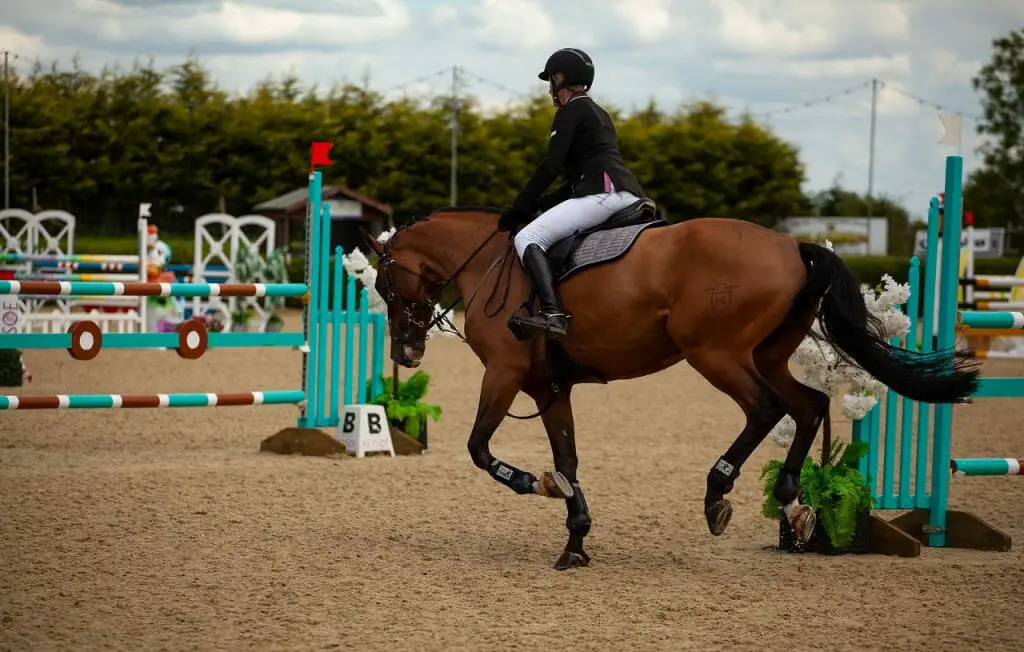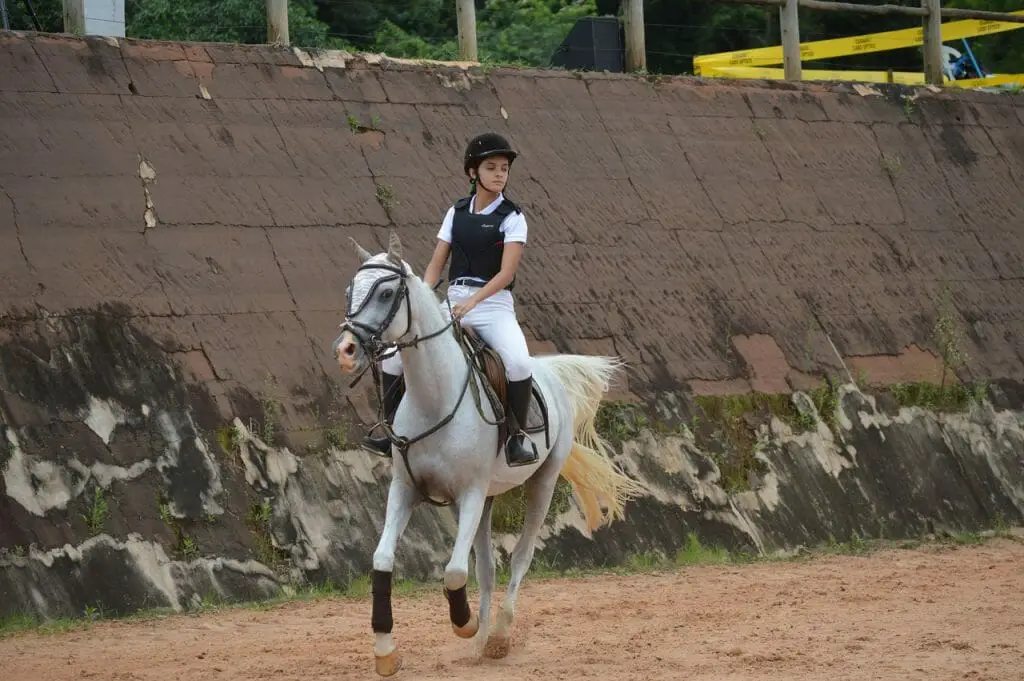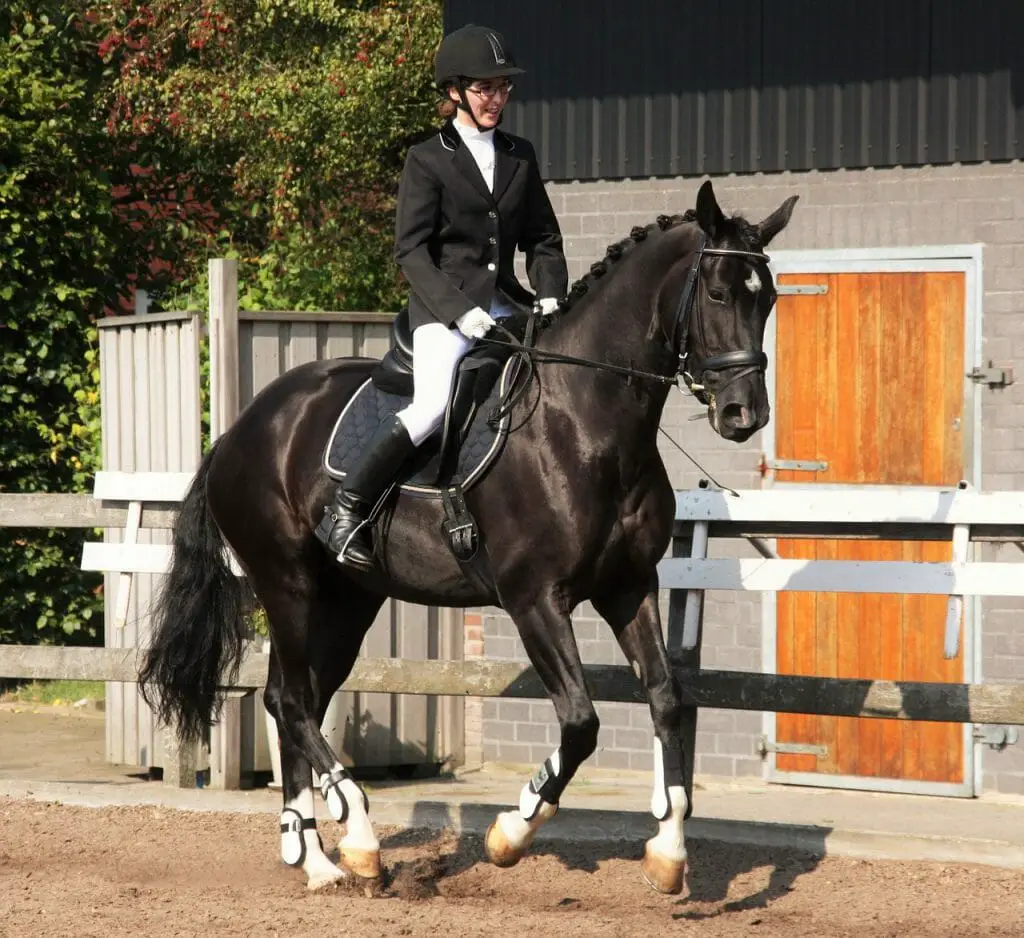You feel like you are going so much faster compared to the trot and you’re out of control. Your form is sloppy and there’s a chance you may bounce out of the saddle. If any of these things describe how you feel when you canter, then sit tight.
Bouncing in the canter is a common problem many riders face. Whether you are starting out learning to canter or you are riding a horse that has a bouncier canter than what you are used to. Maybe you just never learned how to sit the canter and move with the horse.
In order to stop bouncing in the saddle at the canter, you need to have a balanced riding position with your core activated, to move your seat in the same motion as your horse’s back, and to stay relaxed and supple in your joints to absorb the movement.
I am going to give you some exercises and tips to transform the way you sit in the canter that will make you feel more secure, confident, and in harmony with your horse. So you can actually have fun and enjoy cantering your horse.
Why You Bounce At The Canter
It is common to bounce at the canter especially when you are first learning or are a beginner rider. There are several reasons you may be bouncing in the canter.
Here are some reasons you may be bouncing in the canter:
- Bracing or tightening your body while trying to hold the correct riding position.
- Bracing or gripping to try to stay on.
- Sitting in the canter and not moving your seat.
- Moving your seat but you are not in sync with your horse’s back movement

Independent Seat For Less Bouncing At The Canter
The more you develop your independent seat the better you will be able to ride the canter and the less you will bounce. Developing your independent seat is one of the major keys to riding well.
An independent seat is when you are able to stay in balance as you ride and the horse moves underneath you, while also being able to use and move your body parts independently. You do not interfere or hinder your horse’s movement and your body is in sync with the horse’s body.
When you first start riding you will have trouble using your body parts separately and keeping your balance at the same time, it is something you need to learn and practice.
Some examples of not having an independent seat:
- You move your leg back for an aid and your body tips forward. That is lack of control over your body.
- You squeeze your legs to move the horse forward and your hands lift up. The movement of body parts are not separately here.
- You move one rein and the other hand moves at the same time without realizing it, where your that other hand is supposed to stay still and not move.
- You put pressure on the reins to slow down or stop the horse but you also grip with your legs to keep your balance. This is giving the horse conflicting signals.
Some examples of having an independent seat:
- Able to apply aids in a sequence properly and not lose your balance or position.
- Apply a rein aid with one rein and the other hand stays steady, or softens on purpose.
- Signals that are given from the body, meaning seat arms or legs are intentional, not by accident.
- Stays in balance at all the paces and does need to hold on to keep balance.
- Can move each limb individually and keep the others still or in the same spot, while moving with the horse and staying balanced.

How To Move Your Seat At The Canter
How you move your seat or don’t move your seat in the canter will be a big determiner in how secure you feel, in sync with the horse you are and whether you will bounce.
The canter has a rocking horse motion, but add in forward motion and air time much like bouncing on an exercise ball.
The canter will feel a bit different from horse to horse and pony to pony. Some will have quicker shorter strides, some with have long ground eating strides, some will be in the middle.
Some will feel smooth with not a lot of bounce or air time, while others will feel bouncy, rigid or hard to sit to.
I will be giving you some basic tips to moving your seat with the horse. But you will have to adjust exactly how you move with the horse depending on your horse’s own canter.
Here are some tips for moving your seat in the canter.
- Move your seat in a backwards circular motion. Down, forward, up and backward. Much like how I describe for the sitting trot in my guide to stop bouncing at the sitting trot.
- Time the backwards circles with the beat of the canter. 1 stride is 1 backwards circle.
- Longer strides will feel more like a horizontal oval, while shorter strides will feel more like a circle and really short strides may feel more like vertical ovals.
- The phase of the circle goes like this. You seat comes down and forward as your horse comes down onto their forehand. Then your seat goes up and backward when the horse lifts themselves up off the ground and come back into contact with their outside hind leg.
- When you do these circular motions with your hips, have your inside seat bone leading slightly in front. This is because of the way the horses back is in the canter. The inside hind is coming more forward then the outside hind. So the horse’s back is positioned slightly that way as well.

11 Tips & Exercises To Improve & Stop Bouncing At The Canter
1. Learn to sit the trot without bouncing.
If you can sit the trot without bouncing before you start trying to work on your bouncing problem at the canter, you will have an easier time learning to sit to the canter. Sitting the trot though different than sitting the canter is very similar. For both you can think of moving your hips or seat in a circular motion though the timing and shape of the circle is a bit different from the horse’s trot to canter.
2. Make sure your hips are positioned correctly over your seat bones.
Your seat will have a limited range of motion if you are not lined up properly. Meaning you will have a more difficult time moving with the horse and in a less effective position if you are sitting too far back on your butt or too far forward on your crotch.
3. Keep your core strong and move your seat from your hips joints not your back.
You want you abs and back to be stabilized, if you are rolling your seat forward and backwards flexing and moving your back, you will not be as stable and you can hurt your back in the long run. You don’t want to hyper extend your back. This is something I have learned from hurting my own back and not being strong enough in my core and not using my core enough in the canter as well as sitting trot.
4. Separate your upper body from your hips.
Sounds weird I know. You want your hips and seat to move with the horse, but you don’t want to be swinging or pumping with your upper body. Engage your core and make it strong by imagining your belly button going in towards your spine. Your core should stabilize your body, while your hips and below are moving with the horse. Be aware of unwanted stiffness in your arms shoulder and neck and think of those areas becoming more relaxed and softer.
5. Think of your hips, knee and ankle joints as being soft.
If you are stiff and rigid in these joints it will be hard to move with your horse. You want them to be springy, relaxed, soft and moveable so you can flow with the horse.
6. Lunge line lessons to work on your riding position, balance and independent seat.
Lunge line lessons can be a great tool to work on your balance and riding position without worry about controlling the horse. With the person lunging in control of the horse, you can take your focus off controlling the horse and onto control of your own body, moving with the horse, balancing, and correctly positioning yourself. There are a number of exercises you can do on the lunge line to improve in your riding. Some of these exercises I will be mention here.
7. Exercise 1: Practice Cantering On Exercise Ball.
You can do this at home if you have a yoga or exercise ball.
- Sit on the ball with your feet out in front of you flat on the ground. A 90 degree angle if you can behind you knees.
- Practice bouncing on the ball with the backwards circular motion. Try to make the timing of the circles similar to that of an actual canter.
- Work on keeping your upper body stable and still by activating your core.
- But also keep evaluating your body where there may be unwanted tension such as in your shoulders, neck, arms etc.
- Try tying a dog leash, rope or something similar to a door knob for example. To be your reins. Try to keep your hands still at first.
- Then do it moving your hands as if you were following the horses head bob in the canter.
8. Exercise 2: Legs Away.
This is an exercise I also suggest for the sitting trot. The legs away exercise is what it sounds like.
You will take your legs off the saddle and horse but only for a moment. It is almost like kicking your legs out to the sides from your hips like you are trying to do a sideways split.
That’s a little dramatic, you only have to go as far as you are able. But it’s just a quick movement and you allow your legs to come right back to the horse’s sides.
Do this movement whenever you feel yourself starting to grip with your legs, your getting tense in your legs or when you feel like you are rising out of the saddle.
It will put the weight down in your seat to deepen your seat in the saddle and sort of reset your legs to be more relaxed.
9. Exercise 3: Move Your Legs With The Canter.
I actually recently discovered this exercise when I was cantering Chip (my lease horse) bareback.
You will exaggerate the movement of your legs in time with the horse’s canter and the circles you are making with your seat.
This is best done without stirrups so your legs really have the freedom to move.
So being on the lunge line would be ideal. As the horse come down onto the forehand.
10. Exercise 4: Open & Close Thighs In The Canter.
This is just an exercise to loosen up, get your hips moving and unlock lower half if you get tight and grip with your knees.
It also helps with rhythm. Keep your upper body tall and poised.
As the horses front end lifts up in the canter open your thighs off the saddle, as the horse goes down on the forehand close your thighs. Keep doing this for a lap or so each direction.
Then try cantering normally with your thighs gently against the saddle and see if you notice a difference in how you cantered now compared to when you cantered before exercise.
11. Exercise 5: Open & Close Hip Angle In The Canter.
This is very similar to the last exercise except your will be focusing on hip angle not thighs.
The hip angle is the front of the hip between your torso and thigh. When that space gets smaller say because you are squatting and going lower. You are closing the hip angle.
When you stand up straighter you are opening the hip angle. To do this exercise sit up tall and straight. As the horse lifts his front end up your thighs are coming up with the horse and the hip angle is closing.
As the horse goes down onto the forehand you think of how your hip angle is opening up.
Think your upper body stays stable and your legs are the one moving and opening and closing the hip angle.

Conclusion
Bouncing at the canter can be a bit unsettling. Remember to breath.
With the right practice you will get better at the canter and stop bouncing.
Work on your balance at the slower gaits and practice moving your seat in time with the horse’s canter motion.
Use the exercises and tips I have listed and you will be sure to see a difference in your riding.
Just don’t expect to get it overnight. Although who knows you may also find a breakthrough and the key to moving in harmony with your horse,
I hope you found these tips and exercises helpful for getting you to stop bouncing in the canter.
I would love to hear about your progress in the canter and which tips or exercises helped you the most!
Cheers, Kacey

